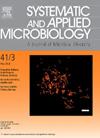从鹿粪便和鼻拭子中分离到一种新的磷霉素耐药菌
IF 4.2
2区 生物学
Q2 BIOTECHNOLOGY & APPLIED MICROBIOLOGY
引用次数: 0
摘要
从野生狍子(Capreolus Capreolus)和马鹿(Cervus elaphus)的粪便和鼻黏膜中分别分离到革兰氏染色阳性、非运动和球状细菌TMW 2.2395T、TMW 2.2628、TMW 2.2670、TMW 2.2756和TMW 2.2757 5株。根据16S和MALDI-TOF质谱分析,分离株具有相同的16S rRNA基因序列,属于巨球菌属。系统发育分析结果显示,三种菌株的平均核苷酸同源性(ANI)均低于原核生物种划分的可接受阈值,其中goetzii型菌株、波西米亚型菌株和表皮型菌株的亲缘性最高,分别为79.59%、79.30%和79.52%。数字DNA-DNA杂交(dDDH)值低于23%,证实所有5株菌株属于大球菌属的新种。所有菌株过氧化氢酶和氧化酶均阳性,在37°C和pH 7.0条件下生长最佳,但耐盐性明显降低(<;7.5% w/v单位迭代率)与该属其他物种相比。此外,本研究的数据表明,这个新物种的成员对磷霉素具有内在的抗性,据推测是由磷sb同源物介导的。基因组大小在2.4 ~ 2.5 Mb之间,G+C含量为34.8% ~ 35.1%。菌株TMW 2.2395T主要呼吸醌为甲基萘醌6 (MK-6, 98.6%),细胞壁肽聚糖类型为A3α L-Lys-Gly3-L-Ser,主要脂肪酸为C14:0、C16:0和C18:0。系统发育、表型和化学分类数据共同表明,这些菌株代表了巨球菌属的一个新种,因此建议将其命名为巨球菌。型应变为TMW 2.2395T = DSM 113939T = LMG 32618T。本文章由计算机程序翻译,如有差异,请以英文原文为准。
Macrococcus capreoli sp. nov., a new fosfomycin resistant species isolated from feces and nasal swabs of deer
Five strains of Gram-stain-positive, non-motile, and coccoid-shaped bacteria, designated as TMW 2.2395T, TMW 2.2628, TMW 2.2670, TMW 2.2756 and TMW 2.2757 were isolated from feces and nasal mucosa of wild living roe deer (Capreolus capreolus) and red deer (Cervus elaphus), respectively. The isolates share identical 16S rRNA gene sequences and are classified within the genus Macrococcus based on 16S and MALDI-TOF MS analyses. Phylogenetic analysis revealed that average nucleotide identity (ANI) values were below the accepted thresholds for prokaryotic species delineation, with the type strains of M. goetzii, M. bohemicus and M. epidermidis showing the highest relatedness values (79.59 %, 79.30 % and 79.52 %, respectively). Digital DNA–DNA hybridization (dDDH) values were below 23 % confirming that all five strains belong to a new species within the genus Macrococcus. All strains were catalase and oxidase positive, grew optimally at 37 °C and pH 7.0, but demonstrated considerably lower salt tolerance (< 7.5 % w/v nit iterativ) compared to other species in the genus. Moreover, the data of this study suggests that members of this new species possess an intrinsic resistance to fosfomycin, putatively mediated by a fosB homologue. The genomes range from 2.4 and 2.5 Mb in size, with a G+C content of 34.8 to 35.1 %. The primary respiratory quinone of the type strain TMW 2.2395T is Menaquinone 6 (MK-6, 98.6 %), the cell wall peptidoglycan type is A3α L-Lys-Gly3-L-Ser and the major fatty acids are C14:0, C16:0 and C18:0. Phylogenetic, phenotypic and chemotaxonomic data collectively suggest that these strains represent a novel species of the genus Macrococcus, for which the name Macrococcus capreoli sp. nov. is proposed. The type strain is TMW 2.2395T = DSM 113939T = LMG 32618T.
求助全文
通过发布文献求助,成功后即可免费获取论文全文。
去求助
来源期刊

Systematic and applied microbiology
生物-生物工程与应用微生物
CiteScore
7.50
自引率
5.90%
发文量
57
审稿时长
22 days
期刊介绍:
Systematic and Applied Microbiology deals with various aspects of microbial diversity and systematics of prokaryotes. It focuses on Bacteria and Archaea; eukaryotic microorganisms will only be considered in rare cases. The journal perceives a broad understanding of microbial diversity and encourages the submission of manuscripts from the following branches of microbiology:
 求助内容:
求助内容: 应助结果提醒方式:
应助结果提醒方式:


